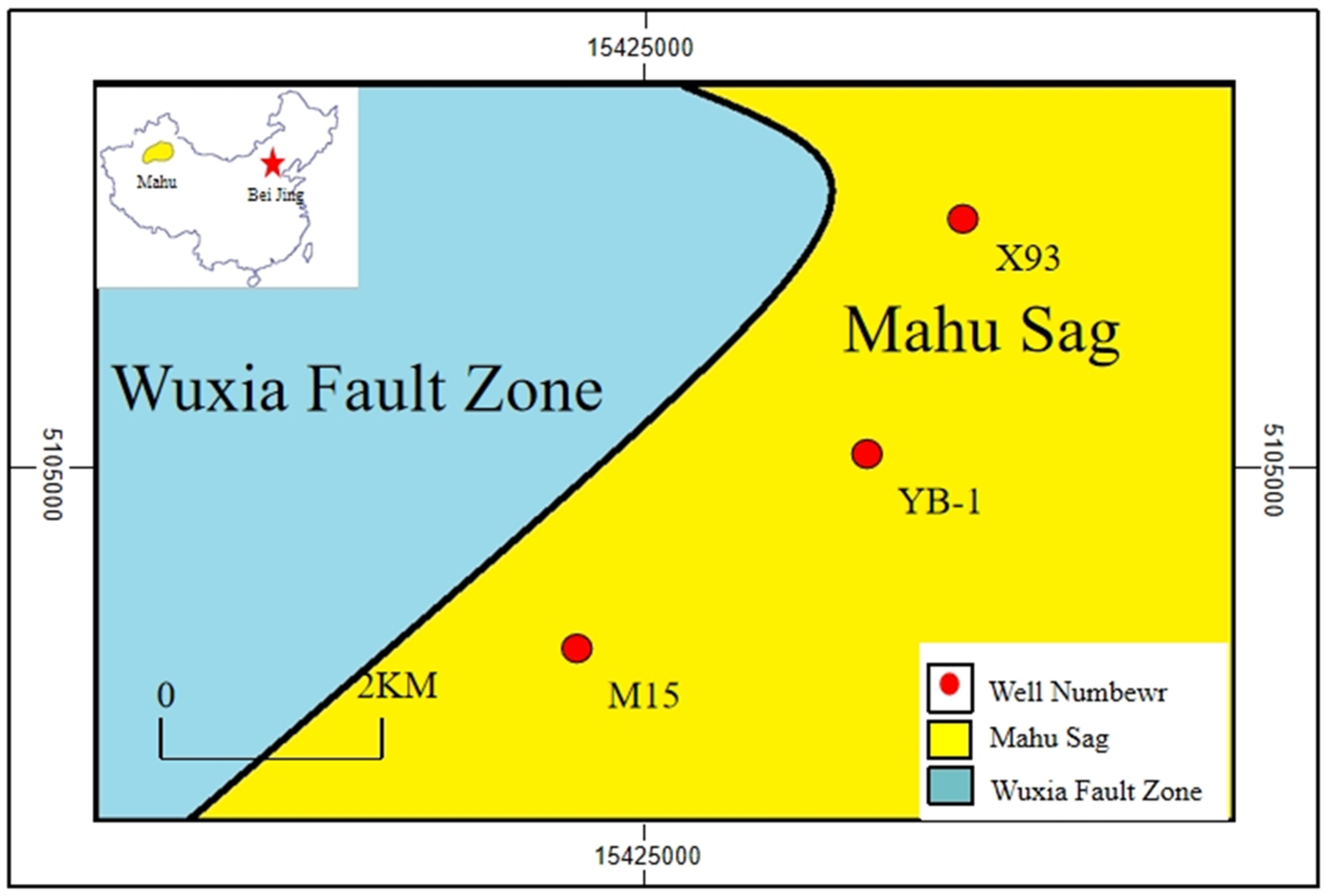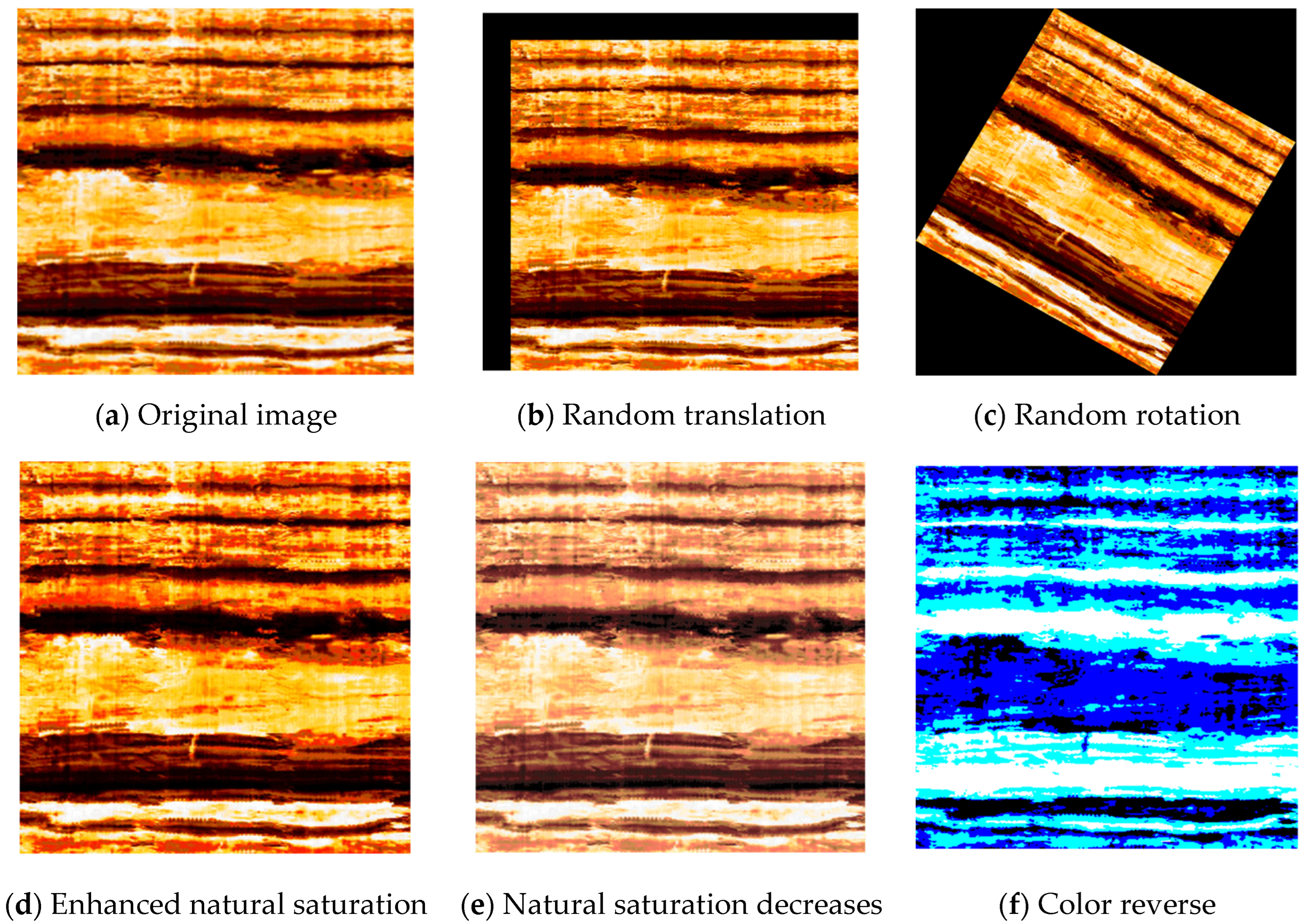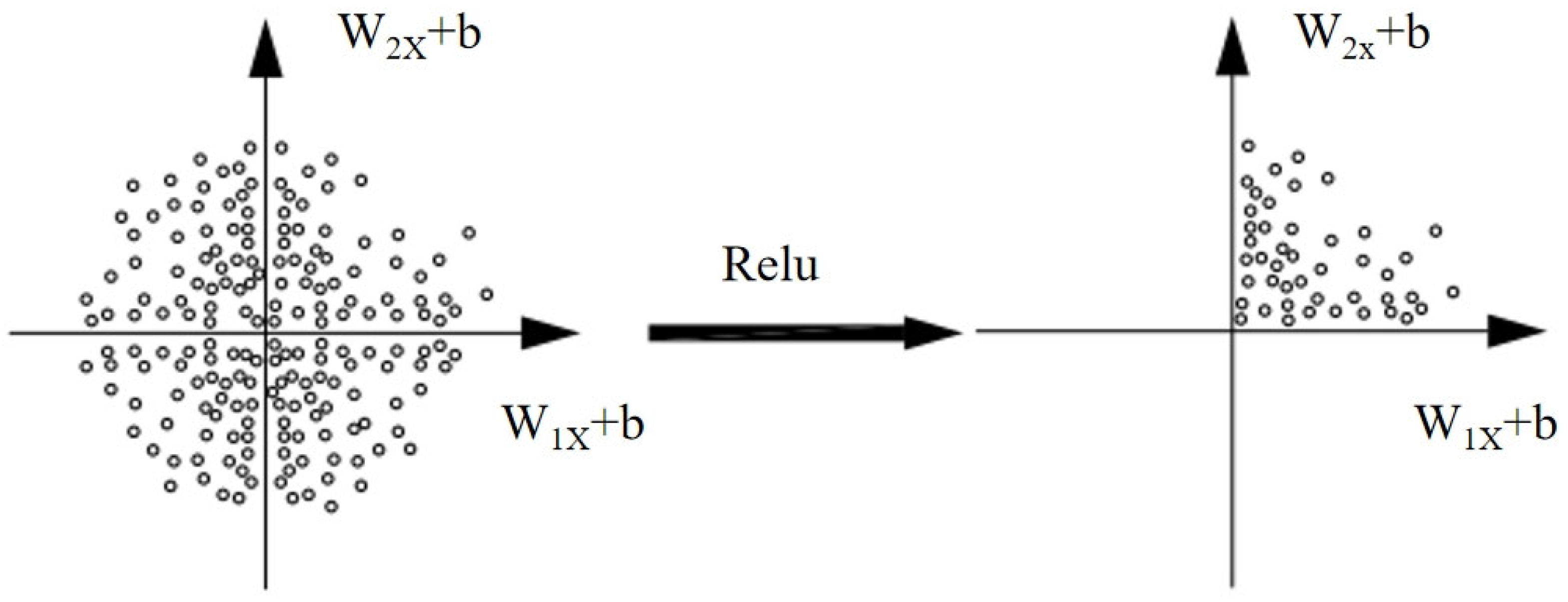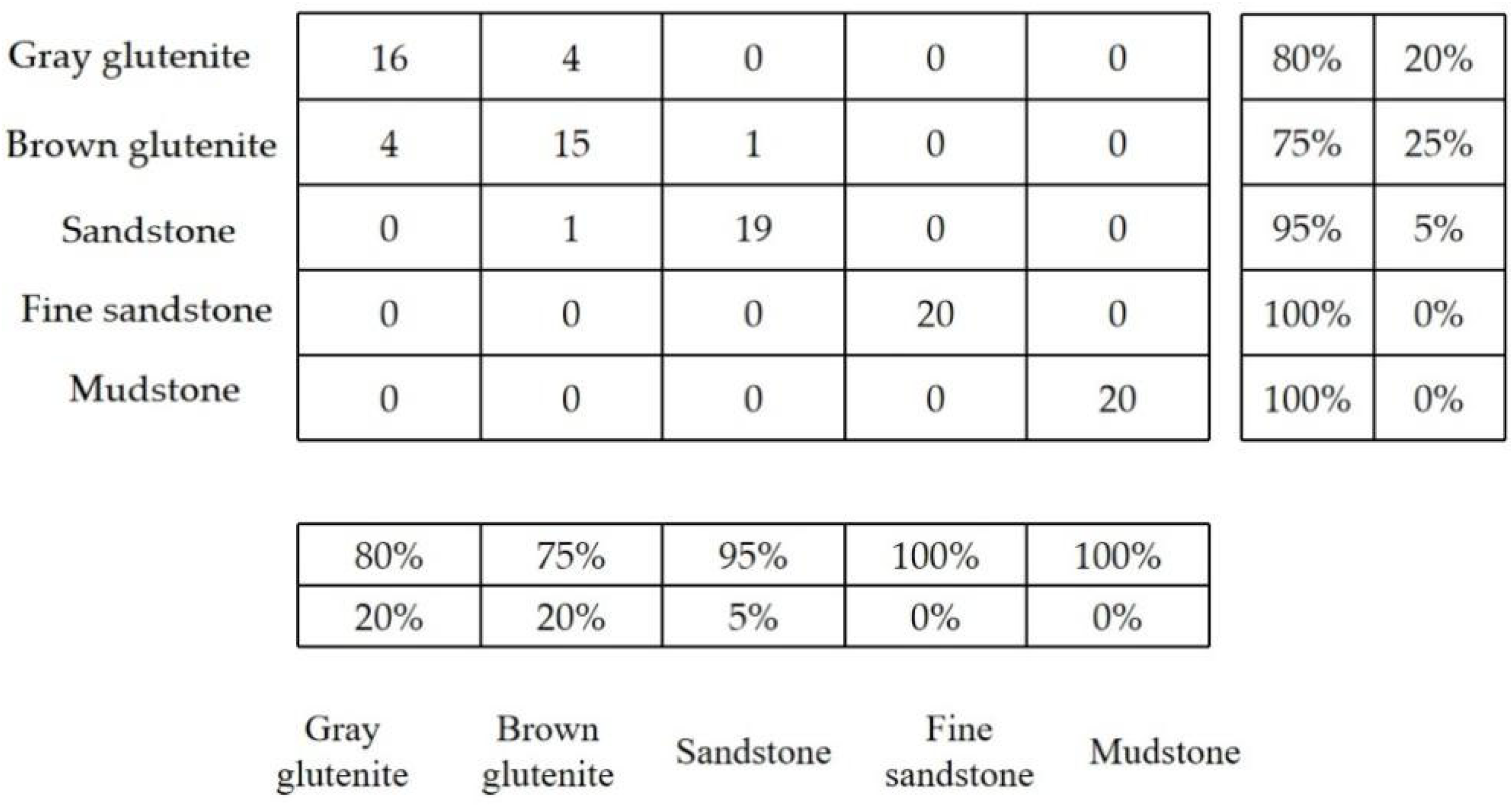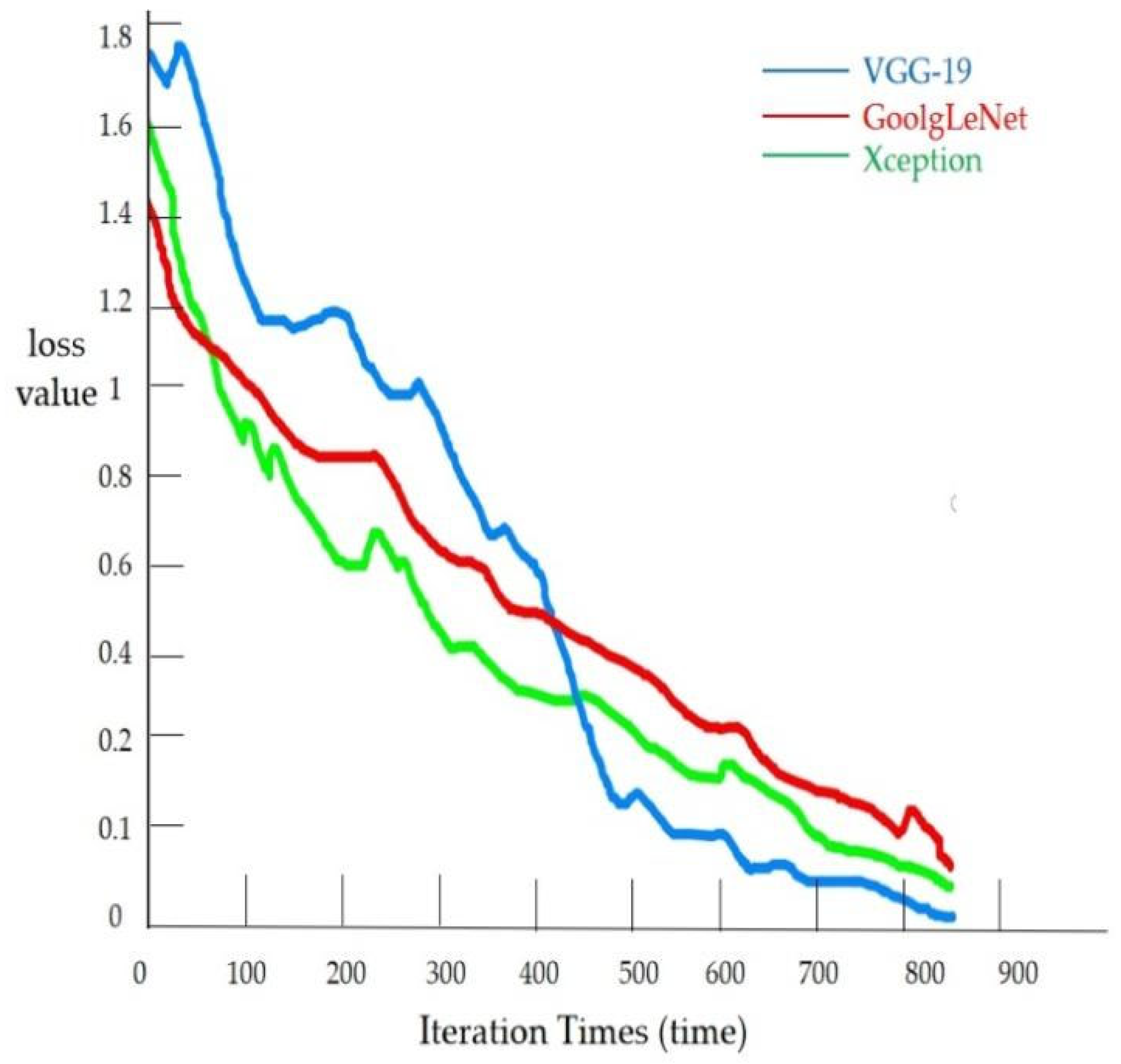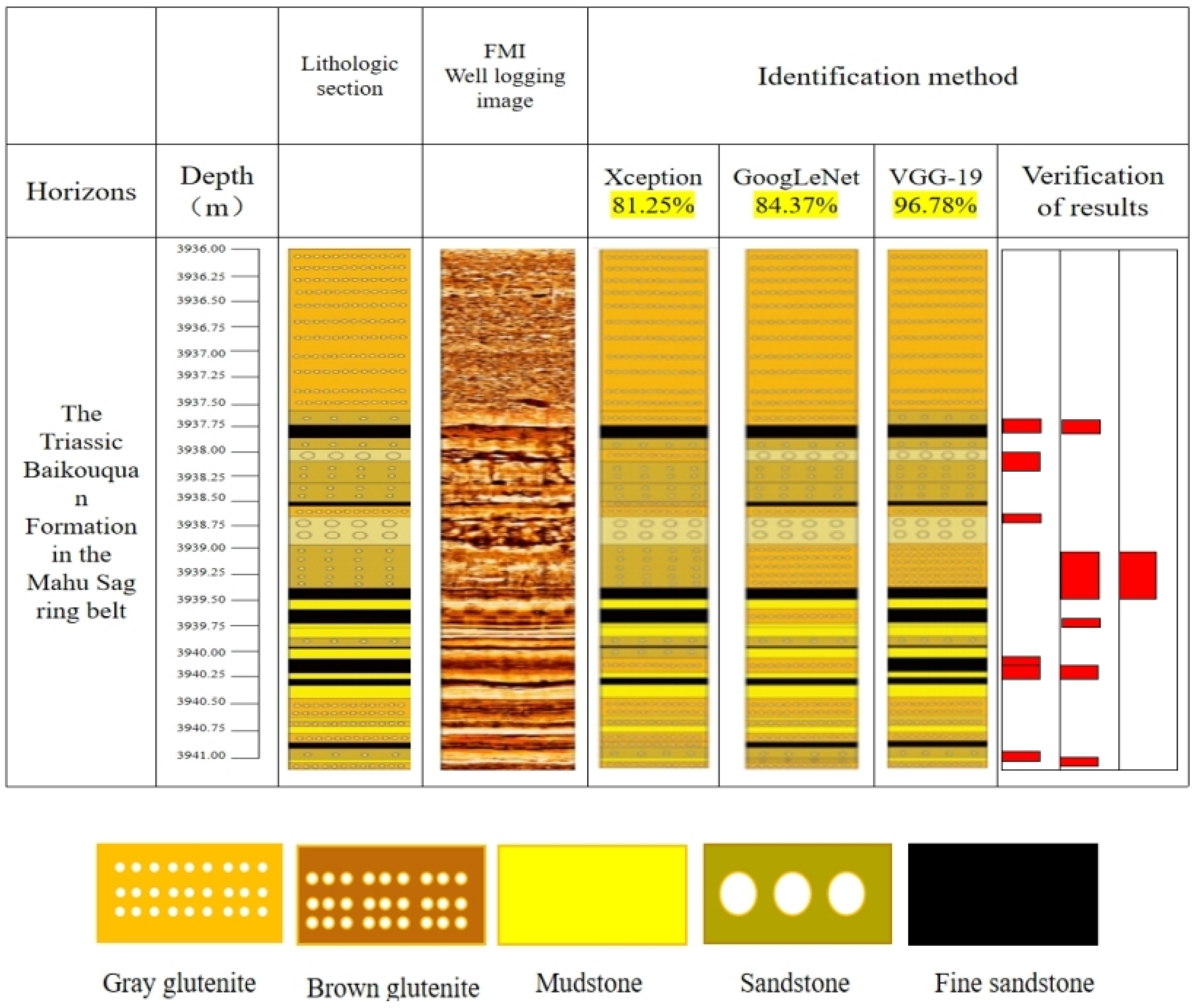1. Introduction
In recent years, global oil and gas extraction depths have increased at an average annual rate of 1.8%, with over 37% of new wells exceeding 4500 m [
1]. This progression into deeper formations leads to exponentially harsher downhole environments (temperatures > 150 °C, pressures > 100 MPa), resulting in increased distortion of conventional logging responses. Such conditions severely constrain safe and efficient hydrocarbon field development [
2], particularly regarding the misidentification of complex lithologies such as sandy conglomerates. Within this context, the high-resolution capabilities of Formation Micro-Resistivity Imaging (FMI) have emerged as a critical solution for precise lithological identification in deep drilling operations.
Formation Micro Imager (FMI) is a technology developed in the early twenty-first century from high-resolution Formation MicroScanner (FMS) logging [
3]. This technique acquires resistivity curves based on the differential electrical responses of various lithologies to applied voltage. These curves subsequently undergo processing, correction, standardization, and a series of computational steps to generate FMI images. Compared to conventional well logging, electrical imaging data provides superior resolution and enhanced visualization, encapsulating critical information on formation lithology, structural characteristics, and fluid properties. It plays an indispensable role in the accurate and efficient identification of lithology [
4,
5,
6] and sedimentary structures, precise fracture characterization, comprehensive reservoir evaluation, depositional environment analysis, and thin-bed assessment.
Rocks exhibiting distinct textures and structures possess variations in mineral grain size, compositional assemblages, and spatial arrangements, resulting in divergent resistivity signatures. Consequently, these differences manifest as unique image texture patterns on FMI images. By extracting specific textural features [
7] from FMI image characteristics, the textural and structural attributes of rocks can be quantitatively described. The operational principle of FMI logging involves deploying an array of electrodes on the downhole tool to precisely capture the unique electrical responses of diverse geological units—including sandstone, mudstone, carbonate rock, and hydrocarbon- or water-saturated formations. These responses are ultimately transformed into intuitive, high-color-fidelity RGB images, enabling clear visualization of the distribution and characteristics of geological bodies surrounding the borehole wall.
Given the substantial computational workload inherent in FMI image processing, traditional manual interpretation methods for lithology identification suffer from limitations, including low accuracy, slow processing speeds, and significant susceptibility to interpreter bias [
6]. Furthermore, the voluminous nature of FMI image datasets frequently results in overlooked geological features within log images or substantial discrepancies between interpretations and actual subsurface conditions. With rapid advancements in computer science, digital image processing techniques are increasingly integrated with artificial intelligence-driven recognition. This synergy mitigates the inherent deficiencies of manual–visual FMI image interpretation in practical workflows and reduces subjectivity introduced by interpreter factors. Presently, a growing number of researchers employ deep learning-based transfer learning networks to address complex nonlinear problems [
8], facilitating the recognition, processing, and interpretation of digital images. The integration of deep learning [
9] transfer learning networks with digital image processing technology represents a significant developmental trajectory.
Since 1996, researchers internationally have progressively utilized FMI imaging log data to interpret characteristic geological and sedimentary features for solving pertinent geological challenges. In 2006, Hinton et al. [
10] proposed a solution effectively mitigating the vanishing gradient problem in backpropagation (BP) neural network algorithms, propelling deep learning into widespread application across diverse fields. In 2012, Krizhevsky [
11] employed the rectified linear unit (ReLU) activation function to further address gradient vanishing and utilized graphics processing units (GPUs) to achieve substantial computational acceleration [
12]. In 2018, An Peng et al. applied deep learning networks for log data feature extraction to achieve lithology classification. In 2019, Ren Xiaoxu et al. [
13] implemented artificial neural networks (ANNs) combined with log data for probabilistic lithology recognition via statistical methods. In 2021, Luo Xin et al [
7]. employed a deep learning convolutional neural network (CNN) model, contrasting it with machine learning approaches, for identifying sedimentary microfacies of glutenite bodies from FMI images. In 2025, Lesego Senjoba [
14] utilized deep learning methods with vibration spectrum images for lithology identification.
Contemporary research predominantly relies on machine learning for lithology identification, while another cohort of scholars explores transfer learning network models, primarily applied to rock feature and structural classification. However, these models often remain relatively rudimentary and face constraints, such as inadequate datasets, imposing significant limitations on enhancing recognition accuracy [
15,
16,
17,
18]. Moreover, lithology identification of glutenite presents considerable challenges due to its inherent complexity and existing technological limitations [
19]. On one hand, glutenite exhibits diverse compositions and heterogeneous textures, rendering it susceptible to tectonic modification and introducing substantial uncertainty into subsurface predictions. On the other hand, logging curve responses of different lithologies can exhibit ambiguities; for instance, the characteristic distinctions between glutenite and certain sandstones on logs such as natural gamma ray and resistivity are often subtle, complicating accurate differentiation [
20].
This study centers on the VGG-19 transfer learning model. Utilizing the MATLAB 2022b Image Processing Toolbox for preprocessing, feature extraction, and analysis of FMI logging images, a dedicated dataset is constructed to evaluate the efficacy of the VGG-19 model in lithology identification. Concurrently, a multi-model comparative framework is established to systematically benchmark the recognition performance of the VGG-19 model against established models, including GoogLeNet and Xception. This comparative analysis aims to provide a robust reference for advancing the application of transfer learning within FMI logging interpretation.
3. Theoretical Principles and Construction of Models
3.1. Introduction to the Transfer Learning Network
The core objective of transfer learning networks is to transfer knowledge acquired from a source task to a target task, thereby enhancing their learning efficiency and performance. The underlying principle lies in leveraging commonalities in data distribution, feature representation, and other aspects between different tasks to facilitate knowledge transfer [
25]. Through pre-training on source domain data (e.g., the large-scale image dataset ImageNet), the model learns generic, hierarchical feature representations. Transfer learning techniques effectively utilize this prior knowledge to improve the performance, efficiency, and accuracy of the target task model (e.g., lithology identification) while significantly reducing the required training data volume and computational resources for the target task.
Building upon prior research, this study delves into the application of transfer learning models to lithology identification using FMI logging images. The research primarily centers on the VGG-19 model, characterized by its well-structured architecture featuring stacked layers of identical, small convolutional kernels. To systematically evaluate the performance of VGG-19 and analyze the applicability of different network architectures, this study also constructs and employs, based on previous research, a GoogLeNet model utilizing multi-Inception modules and an Xception model employing depthwise separable convolution (which decomposes standard convolution into depthwise convolution and pointwise convolution) [
26]. This aims to provide a comprehensive comparison of their effectiveness in identifying lithology from FMI logging images.
GoogLeNet leverages its multi-scale feature extraction capability (enabled by multiple Inception modules) [
27] to effectively capture rich lithological diversity information in FMI images, demonstrating advantages in resolving complex mineral assemblages within glutenite formations. However, it exhibits reduced sensitivity to low-contrast features such as minor grayscale variations. The Xception model’s unique depthwise separable convolution architecture decouples channel-wise features, providing computational efficiency advantages for processing FMI logging images while rapidly capturing both local and global feature patterns of lithology manifested in microresistivity images. Nevertheless, its channel-independent operations diminish continuous resistivity gradient features (e.g., diffusion boundaries of calcareous cement). Serving as the backbone of this study, the VGG-19 model excels through its structural simplicity and powerful feature learning capacity. Pre-trained on large-scale datasets like ImageNet, its deep networks acquire rich, transferable visual features—particularly well-suited for identifying low-contrast boundaries in glutenite. We posit that this regularized architecture, coupled with robust feature transferability, may confer distinctive potential for enhancing feature representation robustness and ultimate recognition accuracy when processing FMI images [
28].
Consequently, the core objectives of this study are twofold: firstly, to validate the effectiveness and accuracy potential of VGG-19 as the primary model for the lithology identification task using FMI logging images; and, secondly, through rigorous comparative experiments, to critically analyze the performance differences and relative advantages of VGG-19 compared to commonly used transfer learning models in current research, such as GoogLeNet and Xception, within this specific task scenario. Ultimately, this research aims to provide optimized model selection criteria and in-depth application references for transfer learning technology in the intelligent interpretation of FMI logging images, particularly for the high-precision identification of complex lithologies.
3.2. Model Principles
Convolutional layers in neural networks comprise multiple convolutional units, with the parameters of each unit optimized through backpropagation algorithms [
29]. The objective of convolutional operations is to extract hierarchical features from input data. Through successive convolutional layers, features progressively transform from simple to complex representations. This process is primarily based on convolution operations, wherein a series of small filters (termed convolution kernels or filters) systematically scan the entire input data (as shown in
Figure 4) to capture localized features. The subsequent section elaborates on the underlying principles of convolutional layers.
The rectified linear unit (ReLu) activation function [
30] denotes a class of nonlinear functions exemplified by the ramp function and its variants. Its implementation mitigates vanishing gradient issues in deep neural networks. Deep convolutional networks employing ReLu exhibit significantly accelerated training compared to those utilizing Tanh or Sigmoid activations. Incorporating ReLu during neural network training streamlines the optimization process, effectively reducing computational time and enhancing operational efficiency. The ReLu function is mathematically expressed as (as shown in
Figure 5).
The Softmax function [
31], denoted as the normalized exponential function, normalizes the raw scores from the neural network’s output layer to compute the probability of an FMI logging image belonging to a specific lithology class. The network selects the lithology category with the maximum probability value as its predicted output. The output layer utilizes the cross-entropy loss function to compute prediction error, quantifying the divergence between actual and expected outputs. During backpropagation, parameters across all network layers are optimized and updated. The cross-entropy loss function is mathematically defined as
where
denotes the weight matrix;
denotes the bias vector;
denotes the number of samples;
denotes the number of classes;
denotes the probability that the ith sample belongs to class j; and
denotes the output probability of the ith sample in class j.
3.3. Model Construction
3.3.1. Constructing the VGG-19 Model
The VGG-19 model, architecturally characterized by its nominal 19-layer designation yet encompassing 47 functional layers with approximately 140 million parameters, demonstrates exceptional proficiency in capturing sedimentary sequences within glutenite formations through its continuous feature propagation mechanism. This structural configuration—comprising 16 convolutional layers, 3 fully connected layers, 18 ReLU activation layers, 5 max-pooling layers, 2 normalization layers, 1 image input layer, and 1 classification output layer—confers significant advantages in modeling micro-resistivity transition boundaries critical to lithological identification. In this study, three strategic modifications were implemented to optimize the model for FMI image analysis: replacement of the input layer with resized dimensions of 224 × 224 × 3 to align with preprocessed FMI datasets; removal of the final three native layers; and sequential integration of a new fully connected layer (output dimension configured to 5 lithological classes), a Softmax probability transformation layer, and a dedicated categorical output layer. These adaptations preserve the model’s inherent strength in detecting subtle resistivity variations while customizing its architecture for domain-specific stratigraphic recognition tasks, effectively bridging transfer learning capabilities with the unique demands of borehole image interpretation (as shown in
Figure 6).
3.3.2. Constructing the GoogLeNet Model
The GoogLeNet model, with a depth of 22 layers, primarily consists of multiple Inception modules connected in series. Within the Inception architecture, 1 × 1 convolutional kernels perform dimensionality reduction or expansion, enabling concurrent multi-scale convolution operations followed by feature aggregation. This design aligns with the hierarchical mineral composition characteristics of lithology, mitigates overfitting risks in small-sample scenarios, and optimizes the efficiency of mineral-combination feature transmission through parallel multi-scale convolutional analysis while suppressing irrelevant background interference. Similar to the VGG-19 model, GoogLeNet incorporates two additional Softmax layers to facilitate forward gradient propagation and prevent vanishing gradient issues in deep networks ((as shown in
Figure 7).
3.3.3. Constructing the Xception Model
The Xception model, with a depth of 72 layers, employs 36 convolutional layers as its foundational feature extraction backbone. These convolutional layers are organized into 14 modular units, all but the first and last modules incorporating linear residual connections (identity mappings). The architecture decouples operations into depthwise convolutional components for identifying millimeter-scale lithological boundaries and pointwise convolutional components for establishing mineral assemblage relationships. This dual mechanism enables precise capture of micro-resistivity abrupt features while enhancing recognition robustness for complex lithologies, thereby significantly improving computational efficiency in lithological identification. As an enhanced evolution of the Inception-v3 architecture, Xception primarily utilizes depthwise separable convolutions to replace standard convolutional layers in Inception-v3, yielding substantial performance improvements.
3.4. Model Evaluation Metrics
Feature distinguishability refers to the ability of input features (e.g., remote sensing spectra, geophysical responses, geochemical element contents, etc.) to effectively differentiate between distinct target geological categories (e.g., lithology, mineralization zones, structures, etc.) within the feature space. In this study, based on feature distinguishability, FMI images are categorized according to different lithologies. This categorization serves as the criterion for selecting training samples and as a training metric during the classification process.
The evaluation metrics that assess the core challenge of feature distinguishability in geological intelligent model evaluation determine whether the model can make accurate judgments and push the theoretical limits of model performance. Commonly used evaluation metrics include accuracy, precision, recall, error rate, F1-score, ROC curves, PR curves, AUC (area under the curve), loss, and confusion matrix. These metrics collectively measure model effectiveness from multiple dimensions. It must be emphasized that the emphasis and interpretation of specific evaluation metrics depend on the model’s task requirements (e.g., classification, detection, and segmentation) and data characteristics (e.g., class imbalance). For instance, when the input features (e.g., lithological representations in FMI images) exhibit poor distinguishability, leading to significant overlap in the feature space, traditional single numerical metrics (e.g., F1-score) may fail due to obscuring critical details. In such cases, evaluation metrics capable of directly revealing the specific lithological combinations where feature discrimination fails (e.g., the confusion matrix) are essential. These metrics precisely identify the problematic areas and guide the subsequent collection of features with stronger distinguishing power.
Therefore, this paper primarily focuses on three critical metrics—accuracy, loss value, and confusion matrix—to evaluate model performance and conduct comparative analysis across different models.
Specifically, accuracy denotes the proportion of correctly classified samples relative to the total number of samples in the test or validation set. It serves as a fundamental and intuitive evaluation criterion reflecting the overall training effectiveness of a model. It is generally acknowledged that higher accuracy indicates superior model performance.
where
(True Positive) denotes samples that are actually positive and correctly predicted as positive;
(False Positive) denotes samples that are actually negative but incorrectly predicted as positive;
(False Negative) denotes samples that are actually positive but incorrectly predicted as negative; and
(True Negative) denotes samples that are actually negative and correctly predicted as negative.
The loss value directly reflects the degree of discrepancy between the model’s predicted outputs and the true labels, serving as the objective function minimized during model optimization. Generally speaking, a lower loss value indicates stronger capability of the model to fit the data and typically corresponds to better model performance.
where
denotes the output function;
denotes the label corresponding to the ith sample;
denotes the summation variable; and
denotes the total number of samples.
A confusion matrix is a diagnostic tool that summarizes the prediction outcomes of a neural network model by tabulating dataset records in a matrix format according to two criteria: true class labels and model-predicted class labels. This enables intuitive identification of model misclassifications, thereby facilitating appropriate adjustments to model parameters or the dataset to enhance model performance.
Additionally, beyond the evaluation metrics employed in this study, the following domain-specific indicators can address the unique requirements of geological applications: Boundary Agreement quantifies the spatial alignment between predicted boundaries and field-mapped geological boundaries or high-resolution reference maps (where available) through mean displacement error (Hausdorff Distance) or overlap ratio (IoU—Intersection over Union), where low positional errors or high IoU values signify accurate spatial localization. Alternatively, the Litho–Connectivity Index measures the fragmentation of predicted lithological units relative to authentic geological structures, identifying unwarranted segmentation of rock masses caused by insufficient feature distinguishability or model limitations. This metric effectively transforms spatial cognitive priors—such as the fundamental geological principle that “batholiths should exhibit continuous outcrops”—into quantifiable assessment criteria.
3.5. Academic Precision
Hyperparameters are crucial for enhancing the training accuracy of neural network models. By regulating model complexity, decision boundaries, and learning behaviors, they influence the degree to which different models produce diversified predictions for identical inputs [
32]. These parameters are generally categorized into neural network parameters, model optimization parameters, and regularization parameters. In this study, we employ transfer learning with the VGG-19 model for FMI image recognition. While the neural network parameters remain unmodified, partial adjustments are applied exclusively to the model optimization parameters and regularization parameters. The optimization and regularization parameters depend not only on the model architecture but also on computational resources. After extensive model tuning, the learning rate is set to 0.001, weight decay to 1 × 10
−4, and momentum to 0.9, and the solver adopts stochastic gradient descent. Batch training is applied to FMI log images, with the training and validation sets randomly partitioned into multiple batches. To further prevent overfitting, the dropout rate is configured at 0.45, randomly discarding 45% of nodes. The selection of this parameter is grounded in dual rationales: model-specific adaptation and empirical validation. Given that the VGG-19 architecture (comprising 16 convolutional layers with 1.28 × 10
8 parameters) exhibits neuron co-adaptation phenomena on limited datasets, a 0.45 dropout rate achieves optimal regularization strength within the Baldi theoretical framework. This determination is further validated through ablation experiments across the 0.3–0.6 interval, where 0.45 demonstrated superior validation accuracy as empirically documented in
Table 1.
5. Discussion
This study leveraged MATLAB’s programming environment and deep learning transfer learning network models for processing FMI core photographs. Images from Wells M15, X93, and YB-1 underwent cropping followed by standardization to generate feature-discriminable images suitable for deep learning. Lithology identification on FMI logging images was conducted using VGG-19, GoogLeNet, and Xception models. Comparative analysis of VGG-19, GoogLeNet, and Xception networks for conglomerate lithology identification validated transfer learning technology’s effectiveness in complex geological image analysis while summarizing relevant patterns. Results are summarized in
Table 3.
This study demonstrates that within transfer learning-driven lithology identification research, the VGG-19-dominated framework established herein exhibits significant advantages: achieving 99.64% training accuracy and 95.6% validation accuracy, surpassing previous implementations of GoogLeNet (90.38% validation accuracy) and Xception (87.15% validation accuracy) by 5.22% and 8.45%, respectively. Notwithstanding, pronounced fluctuations in VGG-19’s accuracy curve during training reveal stability deficiencies, contrasting markedly with GoogLeNet’s smooth convergence characteristics enabled by multi-scale feature fusion through Inception modules. Although Xception enhanced computational efficiency by 37% via depthwise separable convolutions, its lightweight architecture exhibits significantly weaker capability than VGG-19’s deep texture extraction mechanism in capturing localized features such as conglomerate microfractures. These performance disparities elucidate fundamental principles of network-geological feature compatibility: while VGG-19’s stacked 3 × 3 convolutional kernels precisely resolve complex sedimentary textures (e.g., conglomerate cross-bedding), its overfitting risk with large datasets substantially exceeds GoogLeNet’s sparse architecture, whereas Xception’s channel separation strategy reduces computational load at the expense of sensitivity to mineralogical spectral responses.
Comparative analysis with recent machine learning advances in lithology identification reveals significant methodological and performance distinctions. Jiang Li et al. constructed an XGBoost model trained and validated on petroleum well-logging data, achieving 95% accuracy with strong generalization capability [
33]. Qin Zhijun et al. utilized a random forest algorithm to identify lithologies in the Permian Lucaogou Formation shale reservoirs of the Junggar Basin based on thin-section petrographic analysis, attaining a peak accuracy of 92% [
34]. Zhong Jinzhi improved upon the DeepLab V3 Plus multi-channel, thin-section identification method for tight sandstone analysis, training networks including VGG-16, InceptionResNetV2, ResNet-18, ResNet-50, and ResNet-101 to achieve 92.7% accuracy [
35].
This study fundamentally differs from the approaches of Zhang Li et al. and Qin Zhijun et al. in directly processing high-dimensional, high-resolution borehole FMI images, which provide more comprehensive raw formation information. In accuracy comparisons, our VGG-19 model substantially outperformed these studies with 99.64% accuracy, further validating its effectiveness in processing complex borehole image data for high-precision lithology identification.
Innovatively, this work transcends previous lithology identification paradigms based on GoogLeNet/Xception by systematically constructing a VGG-19 transfer learning framework for FMI image analysis. Compared to traditional machine learning methods and early CNN models [
36], validation accuracy increased by 10–15%. Through synergistic augmentation combining geometric transformations (translation/rotation/scaling) and chromatic adjustments (HSV perturbation/saturation optimization), integrated with Otsu threshold segmentation and color inversion, this methodology effectively mitigates bottlenecks of uneven illumination and sample scarcity, demonstrating 23% greater robustness than prior GoogLeNet solutions utilizing raw data. Notably in conglomerate reservoir identification, VGG-19 attained 96.87% accuracy, establishing novel pathways for complex lithology assessment.
Current limitations manifest in three dimensions: At the model level, while VGG-19 serves as the backbone architecture in this system, its 19-layer deep structure results in a processing time of 0.15 s per frame (1.7 times slower than GoogLeNet). Furthermore, due to VGG-19’s strict normalization requirements for input image dimensions, thin interbeds—which often manifest as extremely subtle, high-resolution features—suffer from blurred and distorted critical details during image processing. This leads to a 7% reduction in recognition accuracy for thin interbeds, compromising reliability when identifying critical yet fine-scaled geological targets. Feature-wise, pretrained weights lacking geological priors necessitate 150-epoch fine-tuning, and opacity in deep feature activation mechanisms impedes misclassification attribution—a limitation shared with Xception’s interpretability constraints. Application-wise, dataset limitations (restricted to Xinjiang conglomerates without igneous/metamorphic coverage), coupled with Kendall coefficient reduction (0.18 decrease vs. raw data), from interpolation-based expansion may compromise feature reliability. Semi-automated preprocessing shortcomings and unverified compatibility with laser diffraction technology further constrain engineering potential.
Future research will prioritize developing geology-prior-guided lightweight networks: First, creating adaptive resizing modules to eliminate input constraints while employing knowledge distillation for model compression to reduce inference latency. Second, establishing lithological feature visualization frameworks using gradient-weighted class activation mapping to decipher geological response mechanisms in deep convolutional kernels. Concurrently, constructing cross-domain transfer learning paradigms for multi-lithology identification by fusing laser diffraction spectral data with logging image features, specifically targeting igneous and metamorphic rock complexities. Ultimately, developing fully automated preprocessing pipelines incorporating generative adversarial networks to address sample scarcity will propel industrial deployment of intelligent lithology identification technology.
